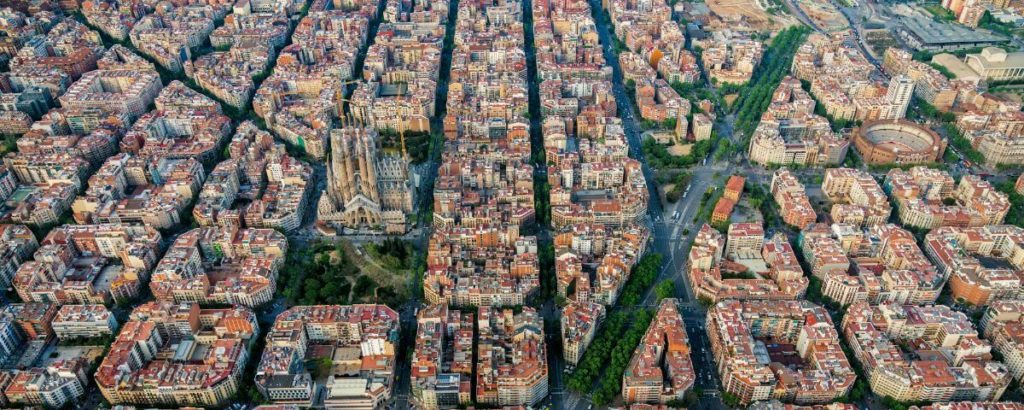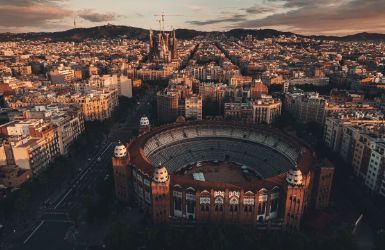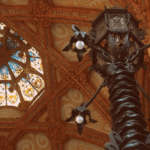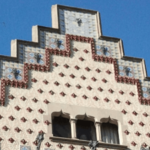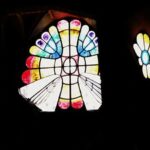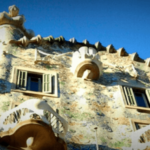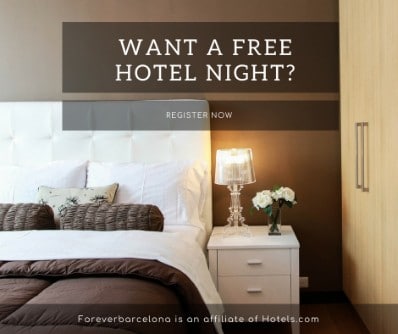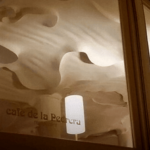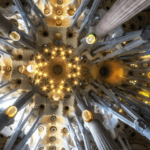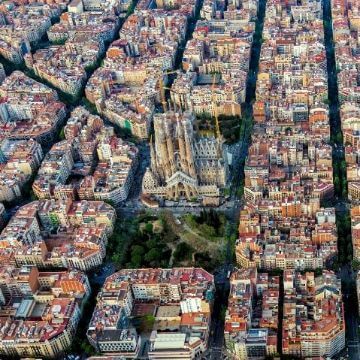
Neighborhoods guide of Eixample in Barcelona
EVERYTHING THE BARCELONA EIXAMPLE HAS TO OFFER
The September 11th defeat in 1714 opened an era of repression for Barcelona. King Phillip V declared the city walls a military zone and had hundreds of neighbors to leave their homes in the Born district so a citadel could be built in that area. With their cannons pointing towards the city to control it, rather than to protect it.
No one was allowed to build right outside of the walls, within one mile of distance – theoretically within cannon ball reach. That forced Barcelona to remain small and closed within its medieval walls. But with the arrival of the industrial revolution, the city population grew exponentially with immigrants looking for jobs in the factories.
The city was packed, dirty and dangerous. And the solution laid past the walls: empty lands waiting to be developed. But it wouldn’t be until 1854 that the Spanish Monarchy passed a law allowing us to knock down the walls and start building a new city beyond them.
In 1859, the architect Rovira i Trias won the city contest for the new urban plan project. However, his radial design was rejected by the Spanish government, who imposed the “chess-game” like plan by Ildefonso Cerdà. Maybe one of the few times in history that an imposition of the Spanish Government has eventually become a wise choice seen with historical perspective…
The Eixample district was the result of Cerdà’s project. And here bloomed the Catalan Modernism, driven by the burgeousie’s desire of showing off their wealth and living in a space surrounded by beauty. It offered Gaudi and his peers the perfect setting to be creative.
And it was also community conscious: The urban plan of l’Eixample was based in a grid of streets crossed by just a few strategically placed diagonal avenues to make getting around easier. It also incorporated designated spaces for food markets, hospitals, firemen stations, schools and other services. Trees lining up the streets and interior gardens added a touch of greenery.
And while it eventually wasn’t executed 100% loyally to the original plan, the Eixample in Barcelona has been the inspiration of many other modern cities that were developed later on. Come with us discovering one of the best places to live in Spain… and possibly the world!
In today’s post we are taking you to the Eixample neighborhoods of Sant Antoni, Nova and Antiga Esquerra de l’Eixample, Dreta de l’Eixample, Fort Pienc and Sagrada Familia. Are they worth checking?
Here is our Eixample neighborhood guide:
1
Sant Antoni district
Young hipsters started frequenting the area more and more, and that led to the opening of more restaurants, mostly tapas and vermouth. Tourists don’t flock it yet, at least not as much as the Boqueria Market and the Born district. But the well informed ones that are looking for new things besides what everyone else does, are starting to discover it.
- Where is it? The Sant Antoni district is shaped as an arrow point, and it limits with Avinguda Paral·lel, Gran Via de les Corts Catalanes, Ronda Sant Antoni And Ronda Sant Pau.
- How to get there?
- L3 (green) subway line, along Avinguda Paral·lel: Plaça Espanya, Poblesec and Paral·lel stations.
- L1 (red) subway line, along Gran Via: Plaça Espanya, Rocafort, Urgell, Universitat stations.
- L2 (pink) subway line, along the Rondas that limit with the Raval: Universitat, Sant Antoni and Paral·lel station.
- Things to do and what to see: The most important feature is definitely the Mercat de Sant Antoni – the largest food market in Spain, featuring also clothing, accessories, collector items and second hand books.
- Where to stay: Hotel Market.
- Where to eat: The neighborhood of Sant Antoni is a foodie destination for its tapas, its vermouth and its vibrant feel. Don’t miss our post on the best restaurants in Sant Antoni.
- Shopping in this Eixample neighborhood: Besides the Sant Antoni Market, we recommend the ceramic workshop Eko Cercamic Space, the urban shoes from Miss Kleckley, and the shirts of Brava Fabrics.
- Parks and green areas: Sant Antoni doesn’t stand out for having many green areas. But you can explore there some “interiors d’illa”, public parks opened inside Eixample blocks. We love the Tres Tombs, accessible from 24-28, Manso street, specially when its cherry trees are blooming in the spring.
- Off the beaten track: 30, Comte Urgell. Considered the first building built in l’Eixample back in 1864, between 2008-2014 it was occupied by a community of squatters that called it “La Carboneria” (the coal-house). They painted a huge graffiti featuring a balloon on its façade, that made the building famous. In 2020, a real-state company bought the place and erased the graffiti, as part of the restoration of the building to make high-end apartments there.
2
Nova Esquerra de l'Eixample
But then the Left Eixample grew too big. So it was divided again: the “older” Left and the “new” Left. So “Nova Esquerra de l’Eixample” means the “New Left of Eixample”. Easy enough!
- Where is it? The Nova Esquerra de l’Eixample is shaped like a pentagon, limited by Gran Via de les Corts Catalanes, Tarragona street, Avinguda Josep Tarradelles, Avinguda de Sarrià and Comte Urgell.
- How to get there?
- L1 (red) subway line, along Gran Via: Plaça Espanya, Rocafort, and Urgell stations.
- L3 (green) subway line, along Tarragona Street: Tarragona and Sants Estació Stations.
- L5 (blue) subway line, along Rosselló Street: Hospital Clínic, Entença and Sants Estació stations.
- Things to see: The former Las Arenas Bull Ring, Joan Miró’s “Woman and Bird” sculpture, the mosaic butterfly of Casa Fajol. The Modernist buildings of Casa de la Lactància and Casa Golferichs. The photography exhibit center Francesc Català i Roca.
- Where to stay: Hotel Villa Emilia.
- Where to eat: Pastries and breakfast: La Desayuneria and the baking school L’Atelier. For tapas and vermouth: Senyor Vermut and Morro Fi.
- Shopping in this Eixample neighborhood: Las Arenas Shopping Mall.
- Parks and green areas: Joan Miró Parc (L’Escorxador). “Interior d’Illa” garden Emma de Carcassona, accessed from 157, Comte Borrell. Its lush vegetation used to be part of a nuns convent.
3
Antiga Esquerra de l'Eixample
The good community vibes it had during lockdown where one of the reasons for it. But also were its cafes, local artists, gayfriendly businesses, repurposing of old buildings… But let me tell you one thing: most of it was in the “Old Left”, the Antiga Esquerra.
- Where is it? L’Antiga Esquerra de l’Eixample is shaped as an irregular polygon enclosed by Gran Via de les Corts Catalanes, Comte Urgell, Avinguda de Sarrià, Avinguda Josep Tarradelles, Diagonal Avenue and Balmes street.
- How to get there?
- L1 (red) subway line, along Gran Via: Urgell and Universitat stations.
- L2 (pink) subway line: Universitat station.
- L5 (blue) subway line: Hospital Clínic station.
- FGC trains: Provença station.
- Things to see: The modernist house Casa Pere Company, now seat of a Sports Museum.
- Where to stay: The Axel is our recommendation for LGTBI travelers, and the Mirror and Granados 83 for everyone.
- Where to eat: Gelato from Delacrem. Catalan food from Bar Gelida. Semproniana, for families with kids. Disfrutar for Michelin star cuisine. And the many fun bars and restaurants along Enrique Granados street.
- Shopping in this Eixample neighborhood: Mercat del Ninot market. Galegory Lego shop. Pepa Paper cool stationery. Alianto, The Avant, M69 and Teresa Helbig for fashion.
- Parks and green areas: The quaint gardens of the Universitat de Barcelona.
- Off the beaten track: Fabrica Lehman, an old toys and dolls factory turned a local creators hub.
4
Dreta de l'Eixample
To their left run the railway track, and the neighborhood in the other side of it was “the wrong side of the track”, where the middle class lived and the high society would never step on. So the right side of the track became was chosen by the bourgeoisie to build their residences.
All the way between Rambla Catalunya and the also elegant Passeig de Sant Joan you can find gorgeous modernist buildings by the top architects of the moment. BTW, Passeig de Sant Joan was named 2nd best street in the world by Time Out in 2021! Only after Melbourne’s Smith Street.
- Where is it? The Dreta de l’Eixample is the central part of the district. It looks like a deformed square that limited with the top of the medieval walls (now Pelai street, Plaça Catalunya, Fontanella street, Plaça Urquinaona and Trafalgar street), Balmes street, Adiagonal Avenue, Córsega and Rosselló streets, Napòls street, Gran Via de les Corts Catalanes and Passeig de Sant Joan.
- How to get there?
- L1 (red) line: Universitat, Plaça de Catalunya, Urquinaona and Arc de Triomf stations.
- L2 (pink) line: Universitat, Passeig de Gràcia and Tetuan stations.
- L3 (green) line: Diagonal, Passeig de Gràcia and Plaça de Catalunya stations.
- L4 (yellow) line: Urquinaona, Passeig de Gràcia, Girona and Verdaguer stations.
- L5 (blue) line: Diagonal and Verdaguer stations.
- FGC trains: Provença and Catalunya stations.
- Things to see: So much! Gaudi’s Casa Mila and Casa Batllo. Casa Amatller and Casa Lleó Morera, making part of the Block of Disagreement together with Casa Batlló. Casa de les Punxes and many other modernist buildings. Museums such as the Fundació Tàpies, the Museum of Modernism or the Egiptian Museum…
- Where to stay: The choices are infinite… You’ll find my recommendations for hotels near Paseo de Gracia and hotels in the city center of Barcelona in our blog. Or stay in Praktik Garden to experience a more local side of this district.
- Where to eat: Again, so many choices! Our post about restaurants on Passeig de Gracia is a good start.
- Shopping in this Eixample neighborhood: Passeig de Gracia for couture designers and European fashion brands. Rambla Catalunya for shoes and accessories. The streets between these two streets for fun smaller stores. Diagonal Avenue between Passeig de Gracia for more cool shops and home decoration. Consell de Cent between Passeig de Gracia and Balmes for art galleries. The Mercat de la Concepció food market.
- Parks and green areas: The tranquil gardens of Palau Robert. The Torre de les Aigües “interior d’illa” park, with its industrial past.
- Off the beaten track: Modernist shops that preserve their original decoration from 100 years ago, such as Queviures Múrria, Forn Sarret or Farmacia Bolós.
5
Fort Pienc
But the rest of it is part of the “real Barcelona”, where nothing much special happens and locals go on their daily lives.
- Where is it? Fort Pienc has a sort of triangular pattern and is surrounded by Passeig de Sant Joan, two blocks of Gran Via de les Corts Catalanes, Nàpols street, Avinguda Diagonal, Avinguda Meridiana and Almogàvers street.
- How to get there?
- L1 (red) metro line. Arc de Triomf, Marina and Glories stations.
- L2 (pin) metro line. Tetuan.
- Things to see: Arch of Triumph. L’Auditori concert hall. TNC (National Theater of Catalonia). The former bull ring La Monumental.
- Where to stay: SM Hotel Teatre Auditori.
- Where to eat: El Puestu for local tapas. The bars of Els Encants flea market for some fun street food.
- Shopping in this Eixample neighborhood: Els Encants flea market.
- Parks and green areas: Parc de l’Estació del Nord.
- Off the beaten track: The Biblioteca Arús library, with its replica of the Statue of Liberty and its franc-mason past.
AND FINALLY! How did Gaudi and Guell meet and what was their relationship?
6
Sagrada Familia neighborhood
If it’s your first time in Barcelona, you’ll definitely be visiting the area. And if you’ve already been here, you’ll likely want to come again to check the progress of the church construction works. But is there anything else interesting in the area?
- Where is it? The neighborhood of La Sagrada Familia is shaped light an horizontal heart. The streets around its perimeter are Avinguda Diagonal, Nàpols street, two blocks of Rosseló street, three blocks of Sardenya street, Sant Antoni Maria Claret street and Dos de Maig street.
- How to get there?
- L1 (red) line: Glòries station.
- L2 (pink) line: Sagrada Familia and Encants stations.
- L5 (blue) line: Sagrada Familia and Sant Pau | Dos de Maig stations.
- Things to see: Gaudi’s hugely famous Sagrada Familia church, of course! And although technically that side of Sant Antoni Maria Claret belongs to the Guinardó neighborhood, let me mention that if you are there you shouldn’t miss the Hospital de Sant Pau either.
- Where to stay: Here you’ll find our favorite hotels near Sagrada Familia.
- Where to eat: Check out this post on places to eat near la Sagrada Familia.
- Shopping in this Eixample neighborhood: Souvenirs all around the Sagrada Familia Church. Some local shops along Avinguda Gaudí.
- Parks and green areas: Not much but the parks at each side of the church, from where you can take great pictures of it.
- Off the beaten track: The “balcons de Barcelona” trompe-l’oeil painting covering and entire wall on Plaça Neruda. It depicts balconies with local historical personalities of Barcelona in them. Let’s see if you can find Gaudi and Picasso on them!
What is your favorite area of l'Eixample district in Barcelona?
Marta
MORE BARCELONA TIPS FOR YOU:
SHARE WITH YOUR TRAVEL MATES
RESEARCHING FOR A TRIP IS TIME-CONSUMING…
Need more inspiration?
Our 100% FREE Barcelona Collection will give you everything you need to organize the trip of your lifetime to Barcelona.
BEST INSIDER TIPS FROM THE PROS!


